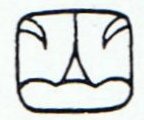|
TRANSLATIONS
What conclusions can be drawn from these 'Rain God' residences? The structure has only 12 residences - when a little child the 'Rain God' has nothing to sit on. Where in the sky is that? We know where the ceiba tree is located, it is the galaxy and at midsummer the tree is standing straight and true - crown up and root (with head) down.
The sign similar to Ik is held in his right hand also at the 4th station. Though it is not drawn exactly the same - the 'rabbit teeth' are high, not hanging low as in the 12th station. 12 - 4 = 8, a sign, we have learnt from rongorongo studies, referring to the moon. At top right in the 4th picture there is a 'tail' with 8 marks to the right (here meaning future because the figure is reversed). At left there are 6 marks, which together means 14. Sun rules the first part of the year, moon the second. Possibly these 14 'periods' are structured as 2 + 4 + 8, in geometric growth. The 'reed bundles' are - I have deduced - signs of sun light not reaching down to us from the sky (the middle sign in the bundles). The horizontal beams (reed straws) must be vertical if we are to benefit from the rays of the 'Rain God'. Why are there 2 bundles? Because there is an overlap between the old and new rulers. The 4th and 12th stations are only 5 stations apart, moving backwards in time. 4 + 13 - 12 = 5 ('fire'). This means the signs like Ik probably together determine the season of maximum growth. 4 and 12 suggest a division of the year into 3 tertials. We should here remember the beginning of side a on Tahua:
With red I have marked what probably is the season of maximum growth. The first 4 glyphs presumably are parallel to the 10-13th stations of the 'Rain God':
A sun child is seen both in location 10 and in Aa1-1. The moon figures in location 11 and in Aa1-2. Then comes a twin 'residence' in location 12, while in Tahua there are twin glyphs, both with associations to the sky. The eagle feather location in location 13 has no separate parallel glyph in Tahua, but the running legs end in what presumably indicates beams of light. These are held horizontally, though, and therefore correspond to the horizontal sun beams in the 12th location, completing the parallel between this location and Aa1-3--4. There are only 12 glyphs in this Tahua calendar, therefore there is not room for the 'eagle feathers'. The meaning is however clear - light is assembled in order to be delivered down to earth. The season of maximum growth is easily grasped from Aa1-5--8, but complicated as described by way of the 'Rain God' residences:
Raising the sky roof to establish a new house at midsummer could be the message in Tahua, while the activities of the 'Rain God' tell much more. The 2nd location is the closest parallel to Aa1-5--8, probably indicating how Ik arrives. Water (1), air (2), and earth (3) is the theme. Footsteps from walking is a way to describe earth. The headgear in 1 has 3 'periods' at the bottom of the front end. In 2 light has arrived and the number has grown to 5 (of course). This type of headgear is parallel to the rongorongo glyph type haú:
It looks similar and it has the same function - to tell about the periods of timespace. The 2nd location has an eagle sign in its glyph, indicating the sky, and on top there is a horizontal sign of tying up. It means, I think, that the sky season (winter) is finished. It corresponds to Hanga Takaure, which lies just before the rise of Poike. The little island Marotiri - we remember - lies just to the south of the coastline of Poike, making it into a possible location for the eagle feathers. Its name says 'feathers', meaning both 'final' of the winter and 'fire' for the summer.
Tiri ought to mean that it has been 'thrown away' - i.e. the old system where the year began with the arrival of summer has been discarded in favour of a new structure with new year at midwinter. The vertical sign of tying up in the 4th location (here with the full sun eye drawn) indicates it is time to tie up (finish with) the season of maximum growth. A new sun sign appears as a twin. The reversal at location 4 can explain why in Tahua the 3rd tertial glyphs have their 'knees' at right:
We should compare with locations 5-9:
Number 9 must correspond to Aa1-12, the burial has been completed. Number 8 refers to the skull and in Aa1-11 we can imagine a severed skull. Number 7 is a residence with (once again, cfr number 12) a double sky sign. The 'Rain God' is also sitting on 'night' (Akbal):
The sky is looked at during the nights. The triplet of locations 1 (on sea), 2 (day sky), 3 (on earth) is reversed with a twist in locations 5 (under earth), 6 (in water), 7 (night sky). From 'on' earth the development leads to 'down into' earth, and down there we find water. The naab (waterlily) in 6 is drawn with the intention (I believe) to mimic the 'digging stick' in 3. 3 'water' locations (5-7) apparently must be parallel to 2 glyphs (Aa1-9--10). |




























